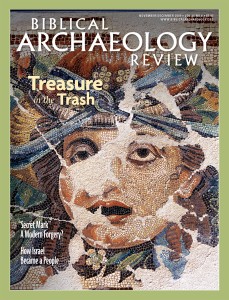Biblical Archaeology Review, November/December 2009
Features
“Secret Mark”: Introduction
In 1973, when Morton Smith presented to the world the Clement letter and an unknown “secret” gospel of Mark, was he revealing an amazing Biblical manuscript discovery or attempting a risky scholarly stunt? With the help of the experts, our four-part treatment sets the scene of the...Read more ›
“Secret Mark”: An Amazing Discovery
Southwest Missouri State University professor Charles Hedrick opens the discussion by setting the stage for us, as we asked him to do, without revealing his own belief in the authenticity of Secret Mark. In 1958 Morton Smith, a 43-year-old Columbia University history professor, spent the summer looking...Read more ›
“Secret Mark”: Morton Smith—Forger
In true BAR fashion, we wanted to present the case for a forgery, a position numerous scholars hold. After being turned down by three major scholars who embrace this position, editor Hershel Shanks undertook to summarize the evidence himself. An increasing number of scholars are concluding that...Read more ›
“Secret Mark”: Was Morton Smith a Great Thespian and I a Complete Fool?
Harvard professor Helmut Koester presents a fascinating textual analysis of Secret Mark. Koester includes an account of his relationship with Columbia professor Morton Smith who discovered Secret Mark (or forged it) and why he believes it is authentic. Secret Mark makes a significant contribution to a better...Read more ›
How the New Testament Gospels Developed
Finds of ancient manuscripts, often fragmentary, and quotations by the Church Fathers have shown that during the first and second centuries, at least ten gospels were circulating.1 The New Testament had not yet been canonized. That the Gospels were joined together in a collection of four and...Read more ›
Early References to a Marcan Source
Our oldest extant manuscript of the Gospel of Mark dates from c. 250 C.E., that is, almost two centuries after its original composition. It is, of course, well established that the Gospel of Mark was written in the first century, because it was then used by Matthew...Read more ›
“Secret Mark”: Restoring a Dead Scholar’s Reputation
Hershel Shanks reveals his own conclusion about Secret Mark as a result of his study of the opposing arguments. My earlier contribution to this discussion of the letter containing Secret Mark is headed “Morton Smith—Forger”. My task was to present, as fairly as I could, the argument...Read more ›
New Studies of “Secret Mark” to Come—Please Help
Strangely enough, despite the dozens of books and articles written on whether Morton Smith forged the Clement letter, no one has turned to handwriting experts—until now. BAR has recently enlisted the services of two Greek handwriting experts. The first is the eminent Greek paleographer Agamemnon Tselikas. He...Read more ›
Treasure in the Trash
The “Adonis of Dor”
Most people, when they first see this hauntingly beautiful mosaic discovered at Tel Dor, think it shows a woman, as did BAR editor Hershel Shanks when he visited the site in the summer of 2008. He compared it favorably with the Sepphoris mosaic that has been dubbed...Read more ›
How Did Israel Become a People?
The genesis of Israelite identity
It used to be easy to identify the earliest Israelites. They are referred to in a well-known hieroglyphic stele known as the Merneptah Stele or, sometimes, the Israel Stele. The Egyptian pharaoh Merneptah, the son of Ramesses II, proclaims in this stele dated to the end of...Read more ›
Past Perfect: A Knight in Bethlehem?
The prologue of The Travels of Sir John Mandeville begins in old-fashioned English, “I, John Mandeville, Knight, albeit I be not worthy, that was born in England, in the town of St. Albans, and passed the sea in the year of our Lord Jesu[s] Christ, 1322, in...Read more ›

